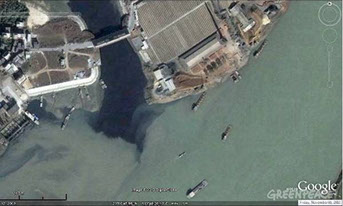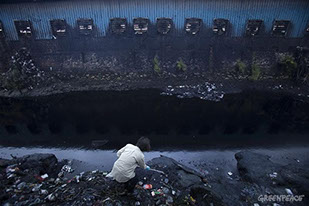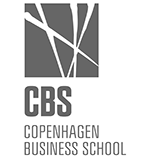3
How your jeans are made
download
teacher's notes
3.1 What is a supply chain?
> Grade: 7th to 9th
> Subjects
- Entrepreneurship
- Sustainability
- Globalisation
a. The journey of a pair of jeans
b. Steps of a supply chain
The first step, Supplying materials
The second step, manufacturing the yarn and fabric
The third step, manufacturing factory
The first step, distribution centre
The fifth step, the store
c. Supply Chain Managers
Second step. The manufacturing of the yarn and fabric.
After the cotton leaves the growing plantation it goes to the fabric factory. Here the fibre gets cleaned again (such clean cotton!). After that, the cotton fibre undergoes several processes that will turn the fluffy cotton flower into a fine yarn. For the manufacturing of the yarn you need to have all the required machinery and up to date equipment.

Check this video to understand how cotton yarn is made (5min)

After spinning the cotton fibre into yarn, it's time to dye the yarn the famous indigo colour of jeans. Indigo has been a very popular dye for thousands of years, but it was only in the last century that a synthetic indigo was invented. The dyeing process requires large quantities of synthetic dye and huge amounts of water. These synthetic dyes are made of chemicals that are toxic, which means any waste water from the dyeing process needs to be treated before being allowed to re-enter the water supply. Unfortunately, many factory-owners try to cut costs by not treating the water properly, leading to the pollution of rivers. This means that the products of conscientious factory-owners who follow the rules are more expensive and less competitive.
The city of Xintang in China produces over 250 million pairs of jeans a year and has become known as the ‘Jeans Capital of the World’, which is some 40 per cent of the jeans sold in the United States. The wastewater from the many factories in Xintang has polluted the River Dong. In the photo below you can see how the dyes are flowing from the river into the Pearl River Delta.
Pictures by Greenpeace
And don't forget about the people working for you. You will need to pay for the operators to work the machines, administrative staff to take care of your accounts, and a cleaning team. All these workers also need medical insurance and salaries.
harvest
verb.
In agriculture, to gather or reap a crop from the place where it has been growing.
In the US, winter wheat is harvested in the early summer.
A
The journey of a pair of jeans
VIDEO
Watch this animation carefully and make a list of all the things Nelson would like to know before buying his new pair of jeans.
Discussion
Take your favourite pair of jeans, for example.
How much of the information Nelson needs can you find on the label?
Can you guess where the fabric they’re made of came from?
What different stages of production did they go through before you bought them?
How many different groups of workers contributed to making them?
And how many countries did they pass through before you bought them?
VIDEO
Watch this animation and complete the numbers below.
1.2 billion...........................................
40%..................................................
35%..................................................
16%..................................................
20%.................................................
90%.................................................
5%...................................................
37 ....................................................
5,000...............................................
THEORY
What is a supply chain?
A supply chain is the term used to describe all the steps needed to deliver a product to the shops. These include processes like gathering the raw materials, production, distribution and storage. When we speak about a supply chain, we are also thinking of all the workers and managers involved in the different stages, as well as things like the energy spent and the water and chemicals used to complete different processes.
You can look at the supply chain from different points of view. For example, if you own a factory you would need to think of the costs of workers’ wages, the chemicals needed, the maintenance of factory machinery, and so on. On the other hand, if you are someone concerned about the environment, you would need to look at the effects of each stage on the environment. For example, you would want to find out whether the chemicals involved in the different processes are harmful to the environment and what the consequences are of using and polluting so much water.
activity
The supply chain of jeans
Take the cards your teacher is going to give you, write the meaning of each process, cut them up individually and then organise them in the right order.
Now, imagine you want to produce your own pair of jeans. What kinds of things are you going to need to make that happen?
The first step. Supplying materials.
The first thing you have to keep in mind is the raw material. In this case, the raw material for a pair of jeans is cotton.
Cotton is a plant that grows in tropical and subtropical regions and it needs huge amounts of water. To grow cotton in an industrial way, you also need pesticides, herbicides and fertilisers. After all of that, the cotton has to be harvested, collected and cleaned, and the fibres separated from branches, seeds and other materials. Following the cleaning, the cotton must packed and sent to the weaving facility where it will be converted into yarn. On top of all this, you must remember that people are involved in every step of the production. You will need to hire cotton collectors, machine operators and administrative staff. These workers need contracts, medical insurance, and salaries.

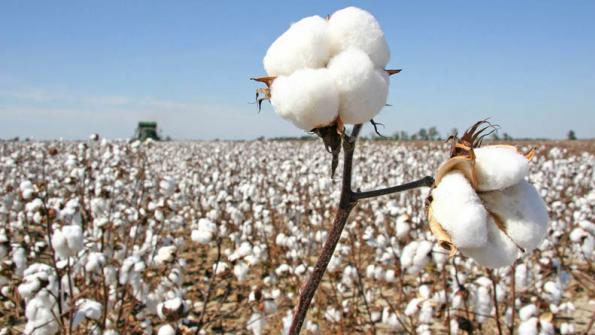
Copyright Agriculture Corner
ACTIVITY
Match the titles below to each paragraph.
a. The use of herbicides and pesticides.
b. The benefits of organic cotton
c. The use of water in cotton production
d. The use of genetically modified cotton seeds
e. The use of fertilizers in cotton production
Cotton production and the environment
Paragraph 1_______________________________________
The heavy demand for water in cotton production has many interrelated effects on the environment. One of the most obvious and devastating effects is the depletion of lakes and rivers to supply irrigation systems for the cotton fields. The use of water from the Aral Sea to irrigate cotton, for example, has reduced what was one of the four biggest lakes in the world to just 10% of its original size. The eastern basin of the lake is now a desert. The destruction of the Aral Sea’s ancient ecosystems, including the extinction of many species found only in this basin, together with the multiple effects of this destruction on local communities and the fishing industry, is one of the worst environmental disasters ever caused by humans. Throughout the world, the use of water for cotton has had complex and harmful effects on groundwater and the water table, as well as causing the salinization of soils, reducing their fertility
Paragraph 2____________________________________________
Another major damaging effect of cotton irrigation is that the water that runs off cotton fields is contaminated with herbicides and pesticides. This is because the vulnerability of cotton to diseases and pests means that industrial producers of cotton spray the fields with massive amounts of chemical herbicides and pesticides. Over 15% of all insecticides and over 6% of all herbicides worldwide are used for cotton production. These chemicals not only have a range of harmful effects on ecosystems and human health, but also end up in the water that runs off cotton fields, polluting freshwater sources and thus depriving people of drinking water.
Paragraph 3_____________________________________________
As well as water, pesticides and herbicides, large-scale industrial cotton production also requires massive amounts of synthetic fertilizers. The fertilizers used in cotton production are amongst the most environmentally damaging of all fertilizers. This is partly because the production and use of these nitrate-based fertilizers involves processes that not only use up a lot of energy but also create nitrous oxide, a greenhouse gas that is one of the major contributors to climate change.
Paragraph 4_________________________________________
Genetically modified cotton seeds have been introduced on a large scale in recent decades, partly to reduce the costs of herbicides and pesticides. Over 80% of the world’s cotton is now grown from genetically modified seeds. Despite the apparent benefits in terms of yield and lower costs, however, the effects of GM cotton on the environment and on cotton farmers are a matter of major and ongoing controversy. Many complex scientific issues are involved in this controversy, but one clear problem with GM cotton seeds is that their success in resisting some pests has led to an increase in the number of other pests – requiring new pesticides. Farmers, meanwhile, have less and less choice about the kinds of seeds they can buy, since the powerful companies that produce GM seeds (i.e. Bt cotton) now dominate the world seed market.
Paragraph 5_________________________________________
An increasingly popular alternative to GM cotton is to grow organic cotton without using any synthetic pesticides or fertilisers. Compost and manure are used instead of chemical fertilisers, a method that enriches rather than depletes the soil. Despite these clear benefits for sustainability, organic cotton products are more expensive than non-organic cotton products. This is partly because governments support non-organic producers with funds and do not make them pay for the environmental costs of their production, making their products more competitive on the market. The big question is whether more big fashion brands will switch to organic cotton if environmentalists and consumers demand more sustainable practices from the textile industry.
THEORY


1. Why do brands outsource manufacturing work to far-off countries?
2. How does the ‘finishing’ stage in producing jeans relate to sustainability?
Discussion





B
Steps of a supply chain
activity

Take the cards your teacher is going to give you, write the meaning of each process, cut them up individually and then organise them in the right order.
THEORY

activity



Take the quiz all together and find out who got the second step of the supply chain of jeans right. Click below to start the quiz.
QUIZ TIME!
Third Step, manufacturing factory
Once the fabric has been made, it is delivered to a factory where the jeans are manufactured.
First, the fabric is cut into pieces in bulk, using a pattern created by a pattern-maker. The pattern-maker bases this pattern on a design for the jeans created by a fashion designer, perhaps one in New York, Paris, London or Copenhagen.
These cut pieces are then sewn together according to the design—a process that can involve up to 37 sewing operations. Sewing is a skilled job, and paying employees who have these skills represents a major cost for producers. This is one of the reasons why this stage of the production is carried out in poorer countries where the wages of skilled workers are low. Having jeans sewn in Western Europe, for example, would greatly reduce the profits of jeans manufacturers and fashion brands.
Using different companies to perform different stages in the supply chain, like sewing, is called ‘outsourcing’. The widespread use of outsourcing is one reason why the supply chain is so complex. It means that no single company is responsible for every stage of the process, and this in turn makes the process difficult to regulate to ensure that people are paid decent wages and to reduce pollution.
After the jeans have been sewn together, they need to be washed and treated to get rid of the stiffness of the denim fabric (Nobody wants to wear stiff jeans!). This process is called ‘finishing’. The finishing of a pair of jeans is the most important stage in making them appeal to consumers. Consumers want jeans that are soft and look cool. For example, they might want jeans that look ‘faded’, ‘worn’ and ‘distressed’. These looks are created in the finishing stage through processes like sandblasting, stone-washing, and acid bathing. These processes require strong chemicals that are extremely dangerous for workers. For example, objections to sandblasting have even led Levi Strauss & Co to call for a ban on the process. The techniques used for finishing jeans also greatly reduce the lifetime of each pair of jeans, again raising concerns about sustainability.
After all the finishing work has been done, the jeans are washed again to get rid of all the chemicals. Metal buttons, zippers and tags are added before the jeans are packed and sent out to distribution centres. The addition of metal buttons and other details to jeans unfortunately makes them much harder to recycle.

Some companies are trying their best to reduce water usage.
Check out this video to see all the processes that Levi's jeans undergo before you can buy them (3min).

Fourth Step, how jeans get from the factory to the shops

After the finished jeans have been packed in the factory, they are sent to a distribution centre. This is a centralised space that receives all the garments produced around the world. For example, if a shop in Copenhagen runs out of black jeans, the shop will ask the distribution centre to send some more.
The distribution centre not only needs enough space to store all the garments it receives, but also workers who can control the machinery and the storage, as well as administrative staff to take care of the accounts and all the orders from the shops. The owner of a distribution centre needs machinery to scan the garments and sort them into the right sets of clothing for each shop. They also need to purchase hangers, cardboard boxes, and plastic bags to repackage some of the garments.
Check out this video if you want to know how a fashion distribution centre workss
THEORY
THEORY
1. What are your favourite clothes shops?
2. What is it you like about them?
3. How do shops make sure they have the products that customers want?
4. What are some of the biggest costs for shop owners?
Pre-reading questions


Fifth step, at the store

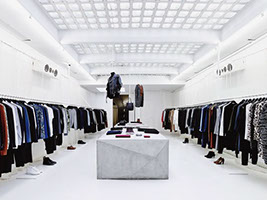
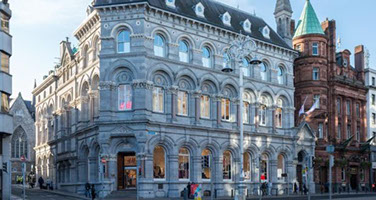
Pictures by www.worlds-luxury-guide.com
We all know what fashion shops look like: large, well-lit and attractive spaces full of beautiful clothes organised in collections. But how do these shops get to look so nice and always have the right sizes and styles available for customers?
To ensure that a shop has all the styles and sizes in demand, the shop managers need to be in constant communication with the distribution centre. While shop assistants are needed to serve customers, refill the stock and keep the stock records up to date. Cleaners are needed to keep the shop looking attractive. And all of these employees must paid a fair salary and provided with health insurance. Other major expenses for retailers include the rent of the building and the bills for electricity and machinery like computers and tills.
THEORY
Imagine you are working in the supply chain of a pair of jeans. Choose one of these groups below and try to figure out all the different stages and materials you will need to produce a pair of jeans. Also, think of the environmental impact each stage can have and all the people you need to involve in the process. Then present it to the rest of the class.
C
The supply chain managers
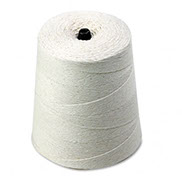
TEAM 2
FROM FIBRE TO YARN
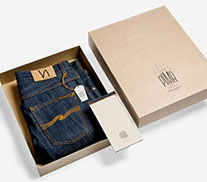
TEAM 4
DISTRIBUTION CENTRE
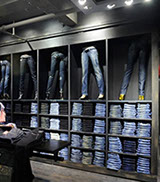
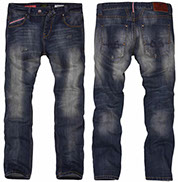
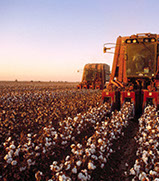
TEAM 1
THE COTTON FARM
TEAM 3
JEANS FACTORY
TEAM 5
THE
STORE
Now you've learned about Supply chains!
GO to:
Math activity
POWERED BY

